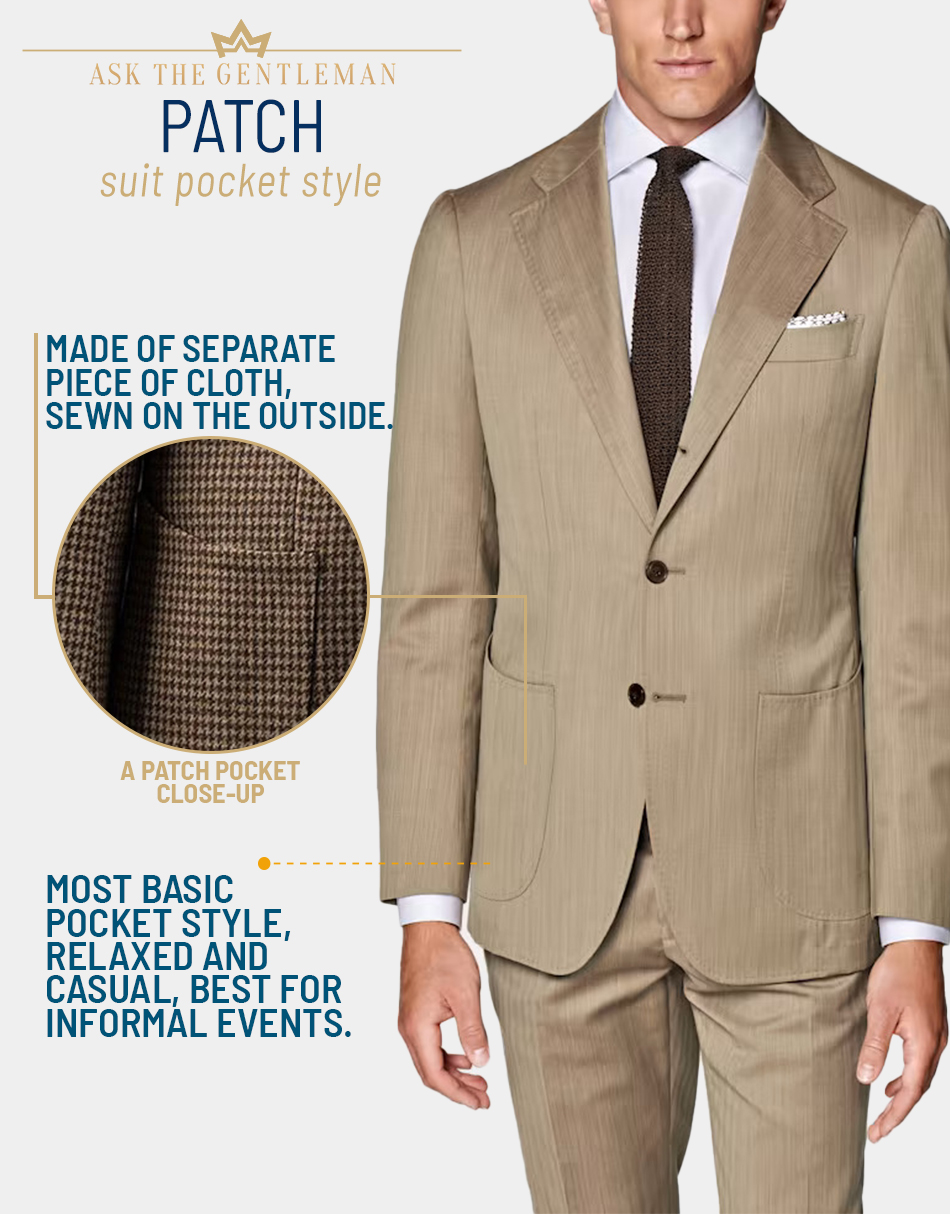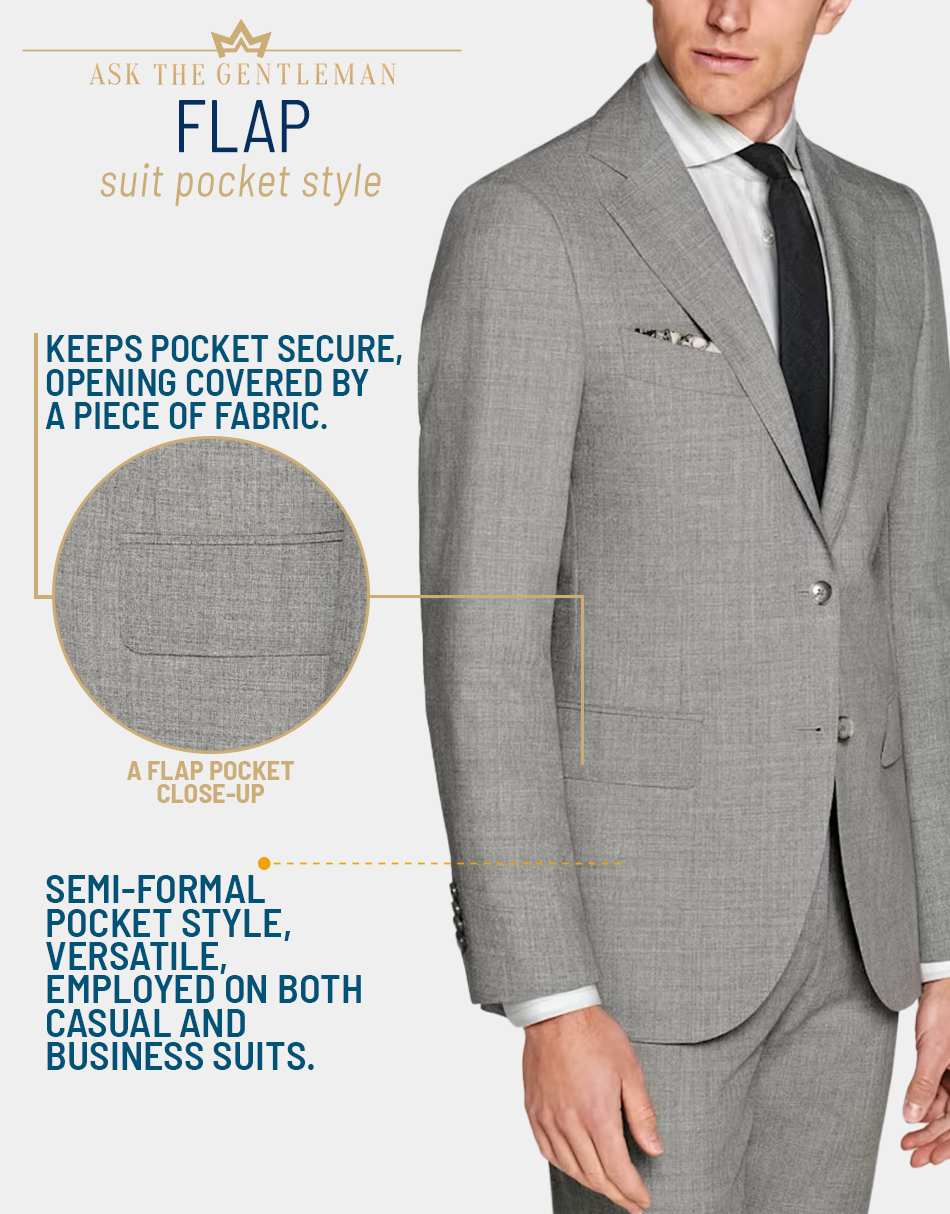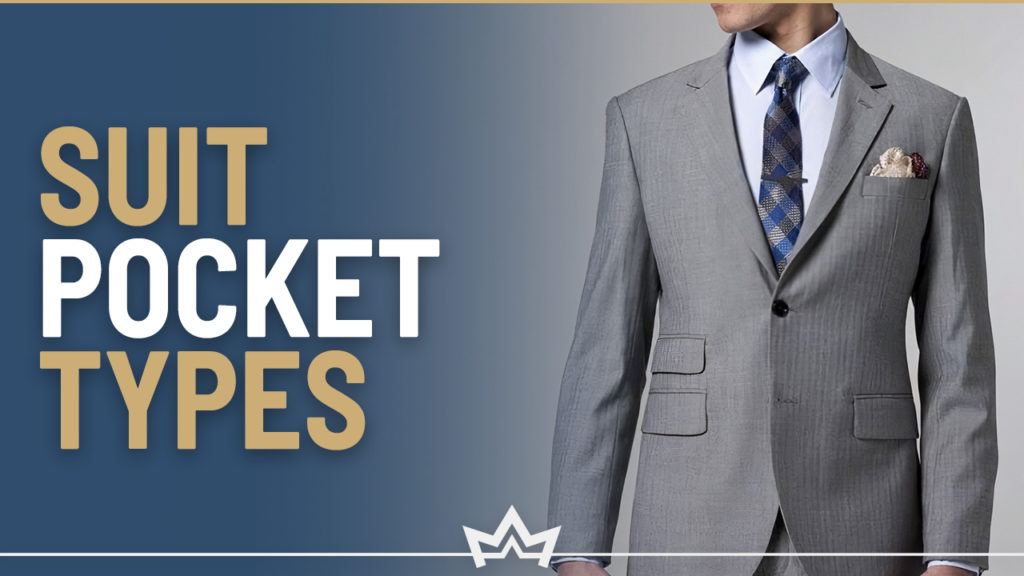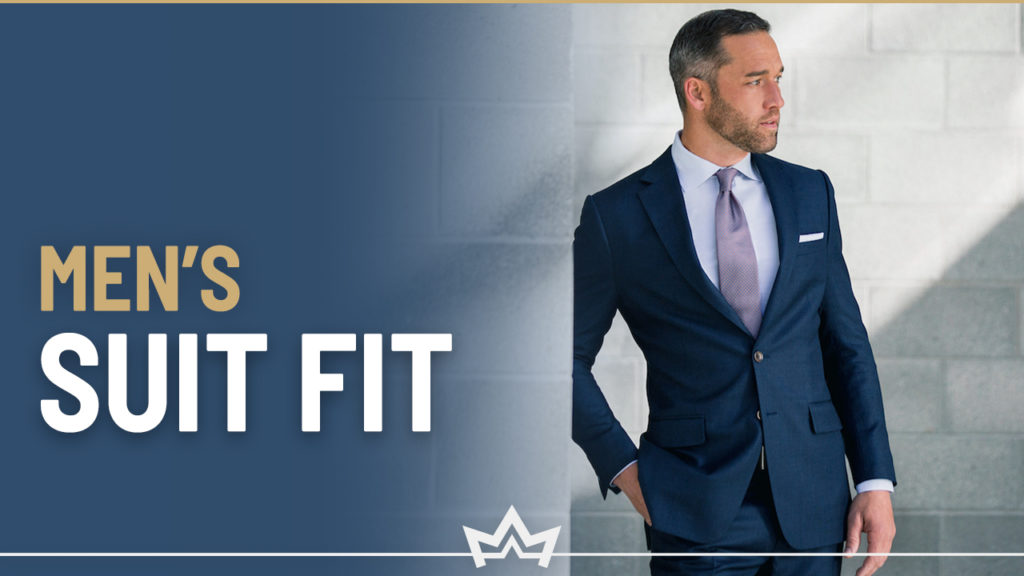Why do I need to learn about different suit pockets?
Aren’t they all the same, and isn’t the pocket simply for storing stuff?
Most men have a similar viewpoint about suit pockets until they learn how each style and type serve a different purpose.
Although small in size, they have a big role to play when it comes to formality and aesthetics.
Here is everything you need to know about suit pockets to ace the gentleman look!
What Do Suit Pockets Represent?
Several features at play collectively make up the sleek look of a suit jacket.
Pockets are one such feature that differs from suit to suit and can be used in distinctive styles.
They help change up to suit aesthetics and make it look formal or casual, depending on your style choice.
However, most people don’t give pockets their due attention, leading to blunders that sometimes make the suit look too odd.
Nonetheless, despite their minor size, pockets are a great way to modify your entire suit.
Slanted Suit Pockets Style
Slanted pockets find their roots in hacking pockets. However, the slant in hacking pockets is more pronounced than in slanted pockets.
This style of pockets has a contemporary touch, so you often see them on sportier jackets.
Most ready-to-wear manufacturers use slanted packets on their suits as well.
They are situated at an angle, making it extremely convenient to access them.
Therefore, it is a great option for anyone who likes to easily slip their hands into jacket pockets.
More importantly, slanted pockets help the wearer come off as more streamlined.
You can either get slanted flap pockets or even jetted slanted pockets.
However, that depends on the formality you seek from the outfit.
Straight Suit Pockets Style
Straight pockets are traditionally popular due to their amusingly classic look.
They are also highly formal as compared to slanted pockets. Therefore, it should be an easy choice if you want to stick to simplicity and elegance.
Moreover, straight pockets have horizontal openings, which is the traditional classic angle for suit pockets.
They can be either jetted or flapped. However, they remain straight pockets as long as they are not at an angle.
Due to their high formality, straight pockets go hand in hand with tuxedos.
Almost anyone can pull off straight pockets. However, they help exaggerate the girth, making you look bulked up.
As a result, a lanky, tall man can benefit more since straight pockets help enhance their silhouette.
Different Suit Jacket Pocket Types
People new to wearing suits aren’t familiar with the different types of suit jacket pockets that exist.
This is fine because most men don’t even know the importance of pocket styles and types.
However, it won’t be fine if you still ignore and use the different pocket types inaccurately.
Let’s go through each type in detail so you can complement your suit jacket with the right pocket type.
Patch Suit Pockets
Patch pockets are the most basic pocket types found on suit jackets.

However, they are also the trickiest to style regardless of their minimalism.
This is mainly because patch pockets are built outside the jacket’s construction, just like a patch stitched on a piece of cloth.
As a result, patch pockets come off as relaxed and casual.
Therefore, they aren’t suitable for business suits. However, you should definitely opt for patch pockets for informal suits and a blazer.
Moreover, patch pockets have a lot of room in them, given their large size.
But this does not mean you should fill them up to the top.
Loading them with too much stuff will fuddle the shape and weigh the jacket down.
Also, you will disbalance the jacket if one pocket is filled with more stuff than the other.
Therefore, you must hold any temptations to use the extension room of patch pockets to its full capacity.
Flap Suit Pockets
The name, flap pockets, itself is enough to describe this type.

Flap pockets are hidden inside the jacket apart from the opening, which is on the outside as a flap.
The flap is thick and rectangle-shaped to cover the entire opening of the jacket pocket.
It is also made from the same fabric as the rest of the suit.
As for the width of the flap, it can vary from suit to suit.
However, in most cases, the lapel width helps determine the flap width as well to keep things in balance.
You can use flap pockets with a wide array of looks except for one; formalwear at a black-tie event.
They are often stylishly employed in casual and business suits. However, they make the best look for formal business suits.
In fact, flap pockets are the most used suit pockets due to their extraordinary versatility.
You can also tuck the flaps inside the pocket as long as they don’t bulk up inside.
Some men do prefer this slit pocket look. However, make sure both flaps stay inside or outside at the same time.
It often happens that you put your hand inside the pocket, and the flap either slides in or out.
Piped Suit Pockets
Piped suit pockets, a.k.a jetted pockets, can be considered a flap and patch pockets hybrid.

This is because they appear as a slit on the side of the suit jacket.
That is one reason why piped pockets are extremely formal and hence most suitable for tuxedos.
The sleek and clean silhouette of piped pockets is perfect for black-tie events as they fall right on the level of formality required.
When compared to other pocket types, piped pockets lack the covering of patch pockets.
They are also incorporated inside the suit jacket, just like flap pockets. Though, you also won’t find a flap on piped pockets.
In fact, piped pockets look extremely similar to flap pockets with the flap tucked inside.
The piping of suit pockets, also known as trimming, is done with the same material as the suit.
However, the piping on tuxedo jackets is done with satin for enriched elegance.
It is also important for the pocket opening to be in line with the bottom button of the suit.
Welted Jacket Pockets
Welted jacket pockets have been around for quite some time.
They were initially introduced to store handkerchiefs placed on the chest of the suit jacket.
However, over time their purpose changed to decorative from storage.
Today, welted pockets are primarily used to add a pocket square to the suit for some flare.
Other than that, welted pockets don’t really have any other function.
They don’t have enough room for you to store anything other than a smart pocket square.
Welted pockets are also sewn inside the suit jacket and are quite similar to jetted suit pockets in terms of design.
You might find flaps on some welted pockets; however, I wouldn’t encourage this combination.
Instead, I would recommend piped welted pockets which are also traditionally famous.
Designers often play around with welt pockets by adding contrasting piping, lace, or buttons.
Other designs include straight or curved openings to take a look up a notch.
Ticket Suit Pockets
Most people don’t know why ticket suit pockets were introduced.
They were originally used on British jackets to help men commute from one city or countryside to another by train.
As a result, they don’t really serve any purpose in today’s world.
However, adding them can be a lovely traditional touch to the outfit.
More importantly, since they are extremely rare, using them on your suit can help make you stand out.
Ticket pockets are typically located on the right side of the suit jacket.
It is sewn just above the regular pocket at the front side and comes in both flapped and jetted styles.
They don’t have much room to hold anything other than a ticket which explains the narrow and not-so-deep design.
Also, you can make the ticket pocket either straight or angled. Just make sure it is the same style as the rest of the jacket pockets.
More importantly, ticket pockets look extraordinary on tall men.
However, short men don’t benefit from them much since they tend to make the suit jacket seem overcrowded.
Inside Suit Pockets
The inside suit pocket is another type of pocket commonly found (you guessed it!) inside the suit jacket.
They are mainly in place for storage purposes with no aesthetic intent since they can’t be seen unless shown on purpose.
They make great storage spaces in suit jackets since they tend to keep everything in balance.
Moreover, they are also quite secure, ensuring your essential items, such as your wallet or phone, don’t fall out easily.
Inside pockets do not have flaps or piping. Instead, they are usually sewn on the inside of the jacket, as simple as that.
Different Suit Pants Pocket Types
It is not just the suit jacket that has a variety of pocket types.
In fact, suit trousers have their own variety of pocket types which you can choose from.
However, it is vital that you keep formality in check and ensure the trouser pockets are in line with the jacket pockets.
Slanted Pant Pockets
Slanted trouser pockets are the most common pocket type for suit pants.
As the name suggests, slanted pockets are cut at an angle. This allows extremely convenient sliding access to the wearer.
The top end of the slanted pocket is angled forward from the seam on the trousers’ side.
As a result, it makes the perfect angle for you to slide your hand inside the pocket.
If you are looking for convenience, you must opt for slanted trouser pockets for all your suits.
I mean, there is a reason why almost everyone prefers them.
On-seam Pockets
The on-seam trouser pockets are also known as vertical pockets.
They differ from slanted pockets in that they are not cut at an angle.
Instead, they go straight up with the outside seam of the pants.
This design helps create a seamlessly streamlined look that looks incredible.
However, the seamless look does come at the expense of inconvenient accessibility to the pocket.
Therefore, if the aesthetic is more important than ease of access, you can opt for on-seam pockets.
But there is another drawback. Sometimes overtight trousers tend to bow open on-seam pockets.
This takes away the clean look, hence tarnishing the whole look of the outfit.
On-seam pockets are traditional in design and often go best with dinner suit pants mainly because they go hand in hand with the out-seam stripe.
Jetted Pockets
Jetted pockets are also found on trousers other than suit jackets.
However, they are known as offset pockets for pants because they are offset from the side seam.
They are pretty similar to slanted side pockets.
However, you get easier access to jetted pockets thanks to the side seam offset, which positions it further forward.
You will mostly find them in a vertical position. But that doesn’t mean you won’t ever see horizontally positioned jetted pockets, similar to cross pockets.
Frogmouth Pockets
Frogmouth pockets are another option for trousers.
They get their name due to the uncanny resemblance to a frog’s mouth.
The design for these pockets is basically the opposite of the vertical slit pocket.
This is because frogmouth pockets have a horizontal orientation at the pants’ front.
Moreover, frogmouth pockets also increase the visibility of the pockets on a suit’s pants.
They have a class of their own and are great for poses where you can tuck your fingers out and keep the thumb in.
They are best used on flat-front trousers since they hinder with pleats.
Coin Pockets
Anyone who has ever owned a pair of jeans knows what coin pockets are.
You know that tiny pocket right next to your regular pants pocket that you have no idea why it exists?
Yes, that seemingly useless, tiny pocket that rests inside the bigger right-side pocket is a coin pocket.
Levi-Strauss originally introduced coin pockets to provide men with suitable storage space for their pocket watches.
Over time, wristwatches took over, and coin pockets lost their purpose.
However, the aesthetic of a coin pocket kept its mark in the world of fashion.
Additionally, with evolution comes adaptation, and today, men use these pockets to store condoms, coins, or even mints for spontaneous dates.
Coin pockets also paved the way for the term “five-pocket pants” alongside the two front and two back pockets on pants.
Coin pockets aren’t a good fit for formal pants if we talk about formality.
Instead, they are commonly used on jeans as well as slightly formal chinos paired with slanted pockets.
Rear Trouser Pockets
Interestingly, there is more variety of rear trouser pockets than front pockets.
Most suit pants have one or two rear pockets, either with or without buttons. But you can even skip the rear pocket altogether.
You can also choose whether you want the simple welt look or add flaps to it.
However, rear pockets don’t offer much functionality despite the various style options.
Yes, you can store stuff in them, but I wouldn’t recommend it unless you plan on standing the whole day.
They can easily disrupt the comfort while sitting if you have something inside.
Moreover, putting stuff in rear trouser pockets can also disrupt suit proportions, so be mindful of that.
As for formality, the simpler design you choose, the more formal it will look.
Dress pants typically have jetted rear pockets often accompanied but a button for aesthetics.
If you add flaps to the rear trouser pockets, the pants become more casual than formal.
Similarly, patch rear pockets are found on jeans, which is again a highly casual clothing article.
Suit Pockets FAQs
What is the standard pocket type for suit jackets?
Flap jackets are the most common pocket type used for suit jackets.
However, this does not mean it is the standard.
There are other options available such as patch and jetted pockets.
It is just that most people prefer flap pockets, so it is closer to being the standard than any other type.
Why are suit pockets sewn shut?
Suit pockets are sewn shut mainly for aesthetic purposes.
Moreover, closed pockets also help keep the suit jacket in shape as long as you don’t wear it.
The sewn-shut pockets also help keep the pocket closed so that the pockets don’t hang open with visible gaps.
Which are more formal, slanted or straight suit pockets?
Slanted pockets are more contemporary as compared to traditional straight pockets.
As a result, since simpler means more formal, straight pockets are the more formal among the two.
How to cut and open suit pockets?
It is extremely easy to cut and open sewn suit pockets.
Simply take a pair of scissors and gently cut through the strings holding the opening together.
In some cases, it is possible to break the strings by force of hand.
However, it is not recommended as it poses a risk to the fabric.





